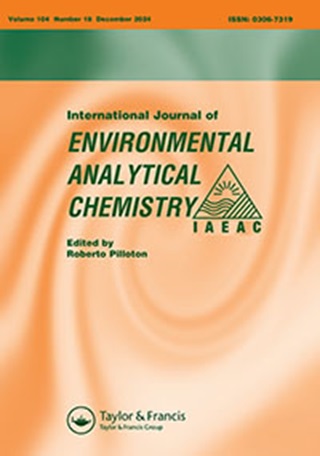Dispersive solid phase extraction using zinc oxide graphitic carbon nitride as sorbent followed by dispersive liquid–liquid microextraction for the determination of organochlorine pesticides from fruit juice samples
IF 2.5
4区 化学
Q3 CHEMISTRY, ANALYTICAL
International Journal of Environmental Analytical Chemistry
Pub Date : 2023-11-09
DOI:10.1080/03067319.2023.2269384
引用次数: 0
Abstract
ABSTRACTIn the present work, we proposed a novel method; dispersive solid-phase extraction followed by dispersive liquid–liquid microextraction for selective extraction and preconcentration of organochlorine pesticides in fruit juice samples. Parameters affecting the performances of both extraction steps have been rigorously studied and optimized. For the dispersive solid-phase extraction, zinc oxide-graphite carbon nitride was used as a sorbent for the first time. In the extraction, 100 mg of the sorbent was added to an aqueous solution. The content was then vortexed thoroughly to disperse the sorbent into the sample solution and to enhance the transfer of the analytes to the extraction phase (sorbent). The extracted analytes were then desorbed using 500 μL methanol. Subsequently, for the dispersive liquid-liquid microextraction, 50 μL of chloroform (as an extractant) was added to methanol-desorbed analytes and then rapidly injected into 5 mL deionised water. After centrifuging, 35 μL of the sedimented phase was withdrawn into an auto-sampler vial, and then 1 μL was injected into a gas chromatography-mass spectroscopy analysis. Under the optimum conditions, the proposed method showed satisfactory analytical performance characteristics: linearity ranging from 0.1–10.24 µg/L with coefficients of determinations (R2) from 0.9948–0.9995; The limit of detections ranging from 0.004–0.01 µg/L; intra- and inter-day precisions expressed as relative standard deviations ranging from 1.1–7.8%, and extraction recoveries varying from 80.8–109.2%. Generally, the proposed method is selective and efficient for the extraction and preconcentration of the target analytes from fruit juices and related matrices.KEYWORDS: Organochlorine pesticidesdispersive solid phase extractiondispersive liquid–liquid microextractionzinc oxide-graphite carbon nitridefruit juices AcknowledgmentsWe are grateful to the College of Natural Sciences, Jimma University for the financial support. Tesfaye, B also acknowledges Dire Dawa University for sponsoring his PhD study.Disclosure statementNo potential conflict of interest was reported by the author(s).以氧化锌石墨氮化碳为吸附剂的分散固相萃取-分散液液微萃取法测定果汁中有机氯农药
在本研究中,我们提出了一种新的方法;采用分散固相萃取-分散液液微萃取法对果汁样品中有机氯农药进行选择性萃取和预富集。对影响两步萃取性能的参数进行了严格的研究和优化。首次采用氧化锌-氮化石墨碳作为吸附剂进行分散固相萃取。提取时,在水溶液中加入100mg吸附剂。然后将内容物彻底旋转以将吸附剂分散到样品溶液中,并加强分析物向萃取相(吸附剂)的转移。提取的分析物用500 μL甲醇解吸。分散液-液微萃取:在甲醇解吸物中加入50 μL氯仿作为萃取剂,快速注入5 mL去离子水中。离心后,取沉淀相35 μL入自动进样瓶,再取1 μL入气相色谱-质谱联用分析。在最佳条件下,该方法具有良好的分析性能:线性范围为0.1 ~ 10.24µg/L,检测系数(R2)为0.9948 ~ 0.9995;检出限为0.004 ~ 0.01µg/L;日内、日间精密度的相对标准偏差为1.1 ~ 7.8%,提取回收率为80.8 ~ 109.2%。一般来说,所提出的方法对于从果汁和相关基质中提取和富集目标分析物具有选择性和效率。关键词:有机氯农药分散固相萃取分散液液微萃取氧化锌石墨氮化碳果汁致谢感谢吉马大学自然科学学院的资金支持。Tesfaye, B也感谢迪尔达瓦大学赞助他的博士研究。披露声明作者未报告潜在的利益冲突。
本文章由计算机程序翻译,如有差异,请以英文原文为准。
求助全文
约1分钟内获得全文
求助全文
来源期刊
CiteScore
5.90
自引率
7.70%
发文量
373
审稿时长
4.4 months
期刊介绍:
International Journal of Environmental Analytical Chemistry comprises original research on all aspects of analytical work related to environmental problems. This includes analysis of organic, inorganic and radioactive pollutants in air, water, sediments and biota; and determination of harmful substances, including analytical methods for the investigation of chemical or metabolic breakdown patterns in the environment and in biological samples.
The journal also covers the development of new analytical methods or improvement of existing ones useful for the control and investigation of pollutants or trace amounts of naturally occurring active chemicals in all environmental compartments. Development, modification and automation of instruments and techniques with potential in environment sciences are also part of the journal.
Case studies are also considered, particularly for areas where information is scarce or lacking, providing that reported data is significant and representative, either spatially or temporally, and quality assured. Owing to the interdisciplinary nature of this journal, it will also include topics of interest to researchers in the fields of medical science (health sciences), toxicology, forensic sciences, oceanography, food sciences, biological sciences and other fields that, in one way or another, contribute to the knowledge of our environment and have to make use of analytical chemistry for this purpose.

 求助内容:
求助内容: 应助结果提醒方式:
应助结果提醒方式:


